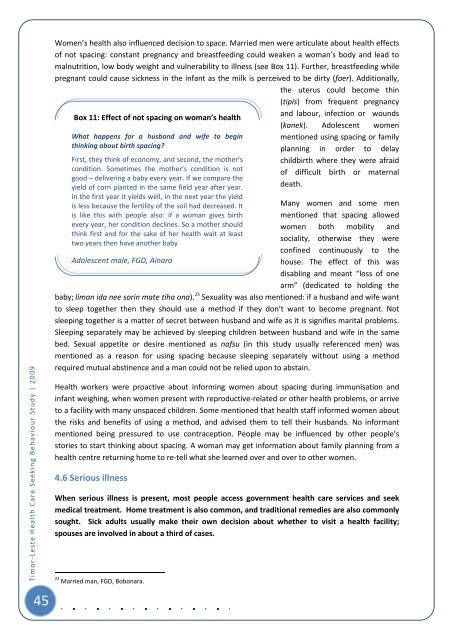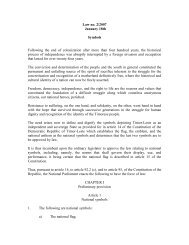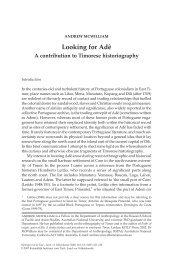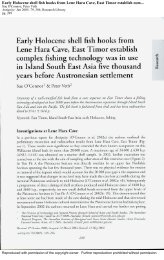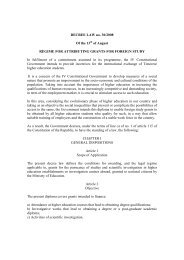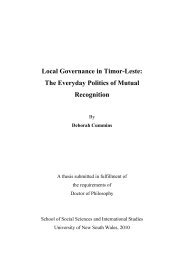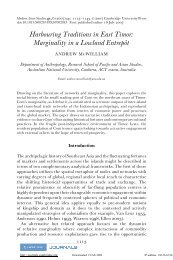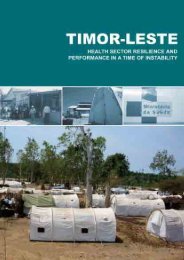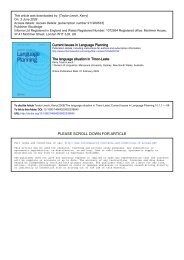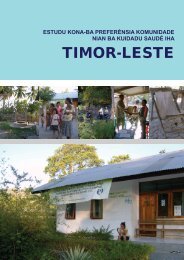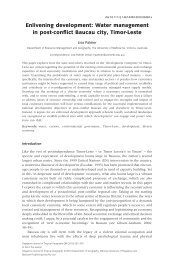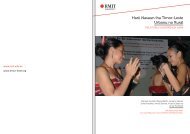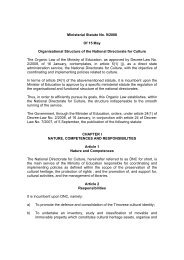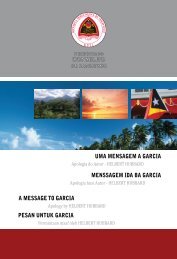Timor-Leste Health Care Seeking Behaviour Study - Secretaria de ...
Timor-Leste Health Care Seeking Behaviour Study - Secretaria de ...
Timor-Leste Health Care Seeking Behaviour Study - Secretaria de ...
- No tags were found...
Create successful ePaper yourself
Turn your PDF publications into a flip-book with our unique Google optimized e-Paper software.
<strong>Timor</strong>-<strong>Leste</strong> <strong>Health</strong> <strong>Care</strong> <strong>Seeking</strong> <strong>Behaviour</strong> <strong>Study</strong> | 2009Women’s health also influenced <strong>de</strong>cision to space. Married men were articulate about health effectsof not spacing: constant pregnancy and breastfeeding could weaken a woman’s body and lead tomalnutrition, low body weight and vulnerability to illness (see Box 11). Further, breastfeeding whilepregnant could cause sickness in the infant as the milk is perceived to be dirty (foer). Additionally,the uterus could become thin(tipis) from frequent pregnancyBox 11: Effect of not spacing on woman’s healthWhat happens for a husband and wife to beginthinking about birth spacing?First, they think of economy, and second, the mother’scondition. Sometimes the mother’s condition is notgood – <strong>de</strong>livering a baby every year. If we compare theyield of corn planted in the same field year after year.In the first year it yields well, in the next year the yieldis less because the fertility of the soil had <strong>de</strong>creased. Itis like this with people also: if a woman gives birthevery year, her condition <strong>de</strong>clines. So a mother shouldthink first and for the sake of her health wait at leasttwo years then have another babyAdolescent male, FGD, Ainaroand labour, infection or wounds(kanek). Adolescent womenmentioned using spacing or familyplanning in or<strong>de</strong>r to <strong>de</strong>laychildbirth where they were afraidof difficult birth or maternal<strong>de</strong>ath.Many women and some menmentioned that spacing allowedwomen both mobility andsociality, otherwise they wereconfined continuously to thehouse. The effect of this wasdisabling and meant “loss of onearm” (<strong>de</strong>dicated to holding thebaby; liman ida nee sorin mate tiha ona). 23 Sexuality was also mentioned: if a husband and wife wantto sleep together then they should use a method if they don’t want to become pregnant. Notsleeping together is a matter of secret between husband and wife as it is signifies marital problems.Sleeping separately may be achieved by sleeping children between husband and wife in the samebed. Sexual appetite or <strong>de</strong>sire mentioned as nafsu (in this study usually referenced men) wasmentioned as a reason for using spacing because sleeping separately without using a methodrequired mutual abstinence and a man could not be relied upon to abstain.<strong>Health</strong> workers were proactive about informing women about spacing during immunisation andinfant weighing, when women present with reproductive-related or other health problems, or arriveto a facility with many unspaced children. Some mentioned that health staff informed women aboutthe risks and benefits of using a method, and advised them to tell their husbands. No informantmentioned being pressured to use contraception. People may be influenced by other people’sstories to start thinking about spacing. A woman may get information about family planning from ahealth centre returning home to re-tell what she learned over and over to other women.4.6 Serious illnessWhen serious illness is present, most people access government health care services and seekmedical treatment. Home treatment is also common, and traditional remedies are also commonlysought. Sick adults usually make their own <strong>de</strong>cision about whether to visit a health facility;spouses are involved in about a third of cases.23 Married man, FGD, Bobonara.45


